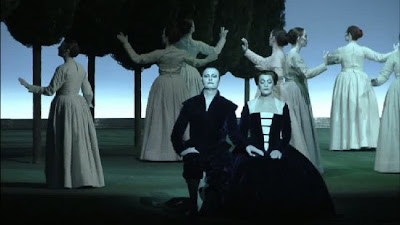Robert Wilson vs. Monteverdi's L'Orfeo.
The female singers are mostly strong. Roberta Invernizzi is impressive as Euridice, especially when she bids farewell to Orfeo at the opera's end. Sara Mingardo sings prettily as Sylvia, and then rocks a great dress as La Speranza (Hope), Orfeo's guide through the black void of Mr. Wilson's stage design. That character has little to do, but Ms. Mingardo rocks a great dress out of a Tim Burton movie. Mention must also be made of the superb La Scala chorus, who cope admirably with the strange stage direction and reveal themselves to be a flexible, compelling ensemble singing with precision and snap.
 |
| Doomed, I tell you: Orfeo (Georg Nigl) and Euridice (Roberta Invernizzi) prepare to get hitched. Image by Mario Brescia © 2011 Teatro della Scala Archives/Opus Arte. |
Theatrical styles clash across a 400-year gulf in this Opus Arte DVD of Monteverdi's L'Orfeo, shot at La Scala. American director/designer Robert Wilson applies his trademark minimalist style to this opera, the oldest work from the Italian renaissance to remain in the repertory today. But fear not. If you can't stand the visuals, turn off the TV and run your player through the stereo. This is a beautiful performance.
Monteverdi's setting of the Orpheus myth is the oldest work in the repertory--a stark retelling of the story that combined dance, solo singing and skilled choral writing in a way that would prove enduring for the next four centuries. First performed in Mantua at the court of the Duke of Gonzaga in 1607, L'Orfeo proved instantly popular. Conceived as an entertainment for the nobility, it was soon discovered to resonate with the common man, sowing the seed for the entire operatic genre.
L'Orfeo takes place on the fields of Thrace and in the underworld below. Mr. Wilson chose a painting by Titian (well actually, a small bit of the background from Venus and Music) to create a Greek grove that, by his standards, qualifies as an actual set. the second act takes place mostly in the dark.There is not much action, but by the standards set by this director's Wagner productions or his work with Philip Glass, this staging is positively hyperactive.
If you've ever seen a Wilson show, you know what to expect. The cast moves about the stage in the trademark "Wilson pose" (one arm extended and one elbow bent, the feet paced slowly and evenly.) They turn slowly, their hands rigid under colored lights and their faces corpse-like under greasepaint. The proceedings have a ritualistic sense which suits the mythic subject matter, and the slowed movements suit the melodic lines in the score.
They may be moving like kabuki actors, but this is still La Scala, and the singing is up to the standard of that famous opera house. Austrian baritone Georg Nigl is better known for singing Wozzeck. Although he produces firm melodic lines, he does not sound idiomatic and is handicapped by the director's demand for a lack of facial expressions. However, his grief comes across, and the scene with bass Luigi Di Donato as Charonte is memorable. That ferryman can't resist a good tune. Giovanni Battista Parodi is even lower and more resonant as Plutone, and looks a bit like David Daniels.
The female singers are mostly strong. Roberta Invernizzi is impressive as Euridice, especially when she bids farewell to Orfeo at the opera's end. Sara Mingardo sings prettily as Sylvia, and then rocks a great dress as La Speranza (Hope), Orfeo's guide through the black void of Mr. Wilson's stage design. That character has little to do, but Ms. Mingardo rocks a great dress out of a Tim Burton movie. Mention must also be made of the superb La Scala chorus, who cope admirably with the strange stage direction and reveal themselves to be a flexible, compelling ensemble singing with precision and snap.
Monteverdi does not make things easier for the conductor, requiring two separate orchestral groups (strings and brass) as well as a e continuo group that does much of the heavy lifting. The players in the first two groups are from the La Scala orchestra. Traditional side drum, wooden flutes, slide trumpets and sackbuts (early, narrow-bore trombones) create an appropriate Renaissance atmosphere. Rinaldo Allessandrini, leading his new, critical edition of the score, conducts all these ensembles with a vivid, pin-point style that makes for compelling listening. Too bad it's not released on CD.
Watch a scene from L'Orfeo here.




